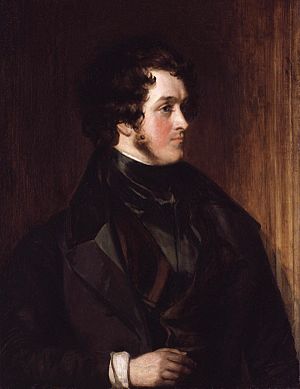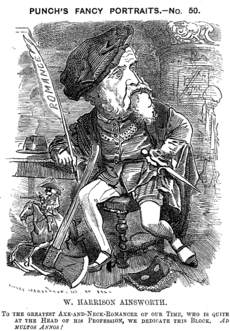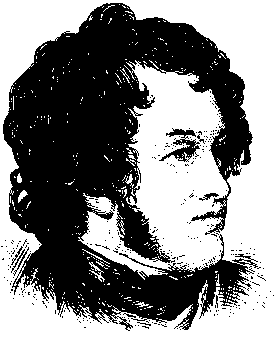William Harrison Ainsworth facts for kids
Quick facts for kids
William Harrison Ainsworth
|
|
|---|---|

Portrait of Ainsworth by Daniel Maclise
|
|
| Born | 4 February 1805 Manchester, England
|
| Died | 3 January 1882 (aged 76) |
| Nationality | English |
| Occupation | writer |
| Spouse(s) | Fanny Ebers (m. 1826) |
| Children | Fanny, Emily, Ann |
| Signature | |
William Harrison Ainsworth (born February 4, 1805 – died January 3, 1882) was a famous English writer. He was known for his historical novels. Ainsworth was born in Manchester, England.
He first studied to become a lawyer. But he didn't really like law. While studying in London, he met a publisher named John Ebers. Ebers helped Ainsworth meet other writers and people in the theater world. Ainsworth also met Ebers's daughter, Fanny, and they later got married.
Ainsworth tried working in publishing for a short time. But he soon decided to focus on writing and journalism. His first big success was the novel Rookwood in 1834. This book featured the well-known character Dick Turpin. After that, he wrote 39 more novels. His last book came out in 1881. Ainsworth passed away in Reigate in 1882. He was buried in Kensal Green Cemetery.
| Top - 0-9 A B C D E F G H I J K L M N O P Q R S T U V W X Y Z |
Who Was William Harrison Ainsworth?
His Early Life and Family
William Harrison Ainsworth was born on February 4, 1805. His family lived in Manchester. His father, Thomas Ainsworth, was a well-known lawyer. His mother, Ann, was the daughter of a minister. William also had a younger brother, Thomas Gilbert.
Their home was a large, three-story house. It was in a nice part of the city. This area had a lot of history. It felt very old and romantic to Ainsworth. This feeling later influenced his writing. As a child, he loved reading adventure stories. He also enjoyed tales about magic and the supernatural. Dick Turpin, a famous highwayman, was one of his favorite characters.
In 1811, Ainsworth's family moved to a new home. It was in Cheetham Hill, north of Manchester. The area had many woods and hills. William and his brother loved playing there. They would act out different stories. When he wasn't playing, his uncle, William Harrison, taught him.
In 1817, Ainsworth started at Manchester Grammar School. He later wrote about this school in his novel Mervyn Clitheroe. He learned a lot there. The school was strict, but Ainsworth was a good student. He was also popular with his classmates.
Starting to Write
Ainsworth began publishing his writings in 1820. He often used the name "Thomas Hall." His first play, The Rivals, came out in 1821. It was printed in Arliss's Pocket Magazine. He published many other works that year. These included stories and poems. He even pretended to find plays by an old writer named "William Aynesworthe." But these were actually his own works!
In December 1821, he sent a play called Venice, or the Fall of the Foscaris to The Edinburgh Magazine. They printed parts of it. They even said he was as good as Lord Byron. Ainsworth also wrote for The European Magazine. He left Manchester Grammar School in 1822. He kept writing for magazines.
After school, Ainsworth started studying law. He worked for a lawyer named Alexander Kay. But Ainsworth didn't want to be a lawyer. He spent his time reading books instead. He read at home and in libraries. He also joined a club called John Shaw's Club.
By late 1822, Ainsworth was writing for The London Magazine. This helped him become friends with Charles Lamb. He sent his poems to Lamb for feedback. His poems were later published as Poems by Cheviot Ticheburn. In 1822, he visited his friend James Crossley in Edinburgh. There, he met William Blackwood, who owned Blackwood's Magazine. Through Blackwood, he met many Scottish writers.
His Early Career
Ainsworth and his friend John Aston started writing together in 1823. They wrote their first novel, Sir John Chiverton. It was about a place called Hulme Hall in Manchester. Ainsworth tried to get it published.
In December 1823, a collection of his stories came out. It was called December Tales. In 1824, Ainsworth started his own magazine, The Boeotian. It only lasted for six issues.
Ainsworth's father died in June 1824. Ainsworth then became more serious about his law studies. He moved to London to study law there. He lived in Devereux Court, a place where many famous writers had lived. He met writers like Mary Shelley.
In 1825, Ainsworth visited Manchester and the Isle of Man. He kept writing poems. Some were published in The Literary Souvenir. This magazine was owned by John Ebers.
On February 4, 1826, Ainsworth turned 21. He became a lawyer. He became good friends with John Ebers. Ebers also owned an opera house. Ainsworth often went to shows there. He fell in love with Fanny, Ebers's daughter.
Ainsworth also wrote a pamphlet about the economy. It talked about problems in Manchester. But by June, he focused on poetry again. He also kept working on his novel Sir John Chiverton.
The novel Sir John Chiverton was published in July 1826. Many people thought Ainsworth wrote it alone. The famous writer Walter Scott even wrote about it. Ainsworth later thought of this novel as unfinished. But it was an important step before his first major novel, Rookwood.

Ainsworth married Fanny Ebers on October 11, 1826. He didn't tell his family or friends much beforehand. Ebers had promised to give Fanny money, but he never did. This caused problems between Ainsworth and his father-in-law.
Ainsworth was encouraged to sell his law business. He then started a publishing business. It did well at first. In 1827, Fanny gave birth to their first daughter, Fanny. Soon after, Ebers went bankrupt. Ainsworth lost a lot of money because of this.
Ainsworth published a few popular books. These included The French Cook. By 1829, Ebers took over Ainsworth's publishing business. Fanny had another daughter, Emily. Ainsworth stopped publishing and went back to law. In 1830, their third daughter, Anne, was born. Ainsworth's family started to have money problems. He went back to writing and worked on his novel Rookwood.
Becoming a Famous Novelist
By 1829, Ainsworth was not a lawyer or a publisher. He missed his younger days in Manchester. He started thinking about writing another novel. He began to travel and gather ideas for Rookwood.
He started writing the novel in 1830. He also worked on some plays. He became friends with William Sergison. They traveled to Italy and Switzerland together. They visited the graves of famous poets. Sergison's home in Sussex also inspired Ainsworth's novel.
After returning to London, Ainsworth worked for Fraser's Magazine. Many famous writers worked there. These included Samuel Taylor Coleridge and Thomas Carlyle. In late 1831, Ainsworth visited Chesterfield. This trip fully inspired him to write Rookwood. He said he wrote it in the style of Ann Radcliffe.
Ainsworth had more money problems from his father-in-law. He couldn't work on the novel again until 1833. He finished much of it while staying in Sussex. The novel Rookwood was published in April 1834. George Cruikshank created the pictures for it.
After five years, Ainsworth quit law. He decided to be a full-time writer. Rookwood was a huge success. It sold well and critics liked it. Ainsworth started dressing very fashionably. He met many famous British authors. He also met Charles Dickens and introduced him to his publisher and illustrator. Ainsworth also helped Dickens meet John Forster. This started a close friendship.
From 1835 to 1838, Ainsworth and Dickens were good friends. Rookwood was printed many times. In 1835, Ainsworth started writing another novel, Crichton. He spent so much time on it that he didn't see his friends much. He had trouble finding an artist to draw pictures for the book. He finally published Crichton in 1837.
Ainsworth's next novel was Jack Sheppard. It was published in parts in Bentley's Miscellany magazine. Dickens's Oliver Twist was also in the same magazine. There was a disagreement between Ainsworth and Dickens. Dickens then left the magazine. Ainsworth took his place as editor in 1839.
Jack Sheppard was published as a book in October 1839. Eight different plays based on the story were performed. After Jack Sheppard, Ainsworth wrote Guy Fawkes and The Tower of London. Both came out in 1840.
His Own Magazine
After his 1840 novels, Ainsworth wrote Old St. Paul's, A Tale of the Plague and the Fire. This story appeared in The Sunday Times newspaper. It ran from January to December 1841. This was a big achievement. He was one of the first writers to have a story in a national newspaper like that.
His next books were Windsor Castle and The Miser's Daughter. They came out in 1842. Ainsworth started his own magazine called Ainsworth's Magazine. He left Bentley's Miscellany to do this. He worked with George Cruikshank, who drew the pictures. The first issue came out in January 1842. The magazine was very popular. Ainsworth's Magazine was the peak of his career.
Ainsworth wanted to publish Windsor Castle in his magazine. But his mother died in March 1842, which caused a delay. The story started appearing in the magazine in July 1842. It ran until June 1843. Cruikshank drew the pictures for Windsor Castle too.
Many famous writers contributed to Ainsworth's magazine. By late 1843, Ainsworth sold his share of the magazine. But he stayed on as editor. His next work in the magazine was Saint James's or the Court of Queen Anne, An Historical Romance. It ran from January to December 1844. This was the last time Ainsworth and Cruikshank worked together on a novel.
In 1844, Ainsworth helped build a monument to Walter Scott in Edinburgh. He also visited many important people. The popularity of his magazine went down that year. This was because it didn't have as many good stories. Even Ainsworth's own work, St James's, was rushed.
During this time, Ainsworth started one of his best novels, Auriol. But he never finished it. Parts of it were published as Revelations of London. Hablot Browne, known as "Phiz," drew pictures for it.
In early 1845, Ainsworth had a disagreement with his publisher. He left his magazine. Soon after, he bought The New Monthly Magazine. He asked writers from his old magazine to join him. He said famous people would write for it. This made some people, like Thackeray, make fun of him. But Thackeray and other writers did contribute to the magazine. Ainsworth also reprinted many of his own works in the magazine.
In 1845, two of Ainsworth's friends died. Later that year, Ainsworth got back control of Ainsworth's Magazine. He kept reprinting his old works. He spent a lot of time finding writers for his two magazines. In 1847, he published a new work, James the Second. He bought the rights to many of his earlier books. This allowed him to print them again. He was also working on what would be his best novel, The Lancashire Witches. The plan for this novel was finished by late 1847. It was to be published in The Sunday Times.
Later Life and Legacy
In April 1872, a play based on The Miser's Daughter was performed. It was called Hilda. On April 6, 1872, George Cruikshank wrote a letter to The Times newspaper. He was upset that his name was not in the play's credits. He also said that the idea for the novel came from him, not Ainsworth. This caused a public argument between them.
Ainsworth was very popular during his lifetime. His novels sold many copies. However, his fame didn't last long after his death. Some critics say his books relied on exciting events. They say he didn't focus much on humor or developing characters.
Historians have noted that Ainsworth mixed facts with fiction in his novels. For example, his romantic story of Dick Turpin became widely believed as true history. His novel about the 1612 Lancashire witch trials also changed real events into a Gothic story.
After his death, Ainsworth was largely forgotten by critics. But his 1854 novel, The Flitch of Bacon, helped bring back an old tradition. This was the flitch of bacon custom in Great Dunmow, England. Married couples who lived together without arguments were given a side of bacon. Ainsworth himself helped restart this tradition. He even gave the prizes for the ceremony in 1855.
Works
See also
 In Spanish: William Harrison Ainsworth para niños
In Spanish: William Harrison Ainsworth para niños


